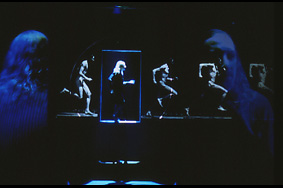


Elsinore © Emmanuel Valette
These questions serve as the starting point for the experience Robert Lepage broaches with this piece. Following Vinci and Needles and Opium, Robert Lepage comple-tes his trilogy of solo shows by taking on Shakespeare's Hamlet and pre-senting us with his own personal vision of Shakespeare's play in a work entitled Elsinore.
Like the works of Cocteau and the music of Miles Davis in Needles and Opium and the life and works of Leonardo Vinci, Hamlet is the score on which this new creative adventure is based and acts as its main source of inspiration. This is not simply a question of putting on a performance of Shakespeare's famous play, since the text may be cut, summarised, reinterpreted, restructured and reor-gani-sed, but rather of travelling through the play's physical and fantastical world, as suggested by the proposed title of the piece.
From the many interpretations which can be made of the work, Lepage has chosen to stress the themes of mourning, family and madness. Modern technology is used partly to throw a new light on the text, peeling away its successive layers in an attempt to see through it, and partly to resolve the problems involved in putting on as a solo work which contains so many characters. In fact, one might imagine that all the characters are simply reflections of Hamlet himself – that they are part of his paranoia, the figments of an imagination overcome by grief. One might at least think that they are all somewhat similar since they are mostly related to one another, and be-cause the ambiguity of their feelings for one another hints at incestuous relation-ships. It is therefore feasible that the va-rious members of the royal family could be played by a single actor, and where appropriate (in the case of Rosencrantz and Guildenstern for instance), they can be conjured up by stagecraft, perhaps by using cameras to show the audience the point of view of the characters in ques-tion rather than showing the characters themselves, thereby creating a sort of multi-image effect, increasing the sense of Hamlet's madness and emphasising the play's claustrophobic atmosphere where everyone seems to be spying on everyone else.
Various types of videographic techniques are used to show the audience things that they would not normally be able to see ¬infra-red and thermal cameras, sonar, slides, all make it possible to see behind walls and tapestries or enlarging small details, sets of screens and panels focusing on a particular item, image or virtual reality characters. The lighting is also of prime importance, as it is used to pick out certain areas and give a three-dimensional aspect to the nocturnal and spectral world whose blackness is not only a material blackness, but also represents Hamlet's mourning, being not only the colour of his clothing, but also of his despair and his mental confusion.
This is an extremely visual work, but it also has a strong musical side, since both the sound effects and the original musical score will be used to give the play the style of an opera or oratorio. However, this is not just a modernised version of Hamlet, since the sets and costumes are Elizabethan in style and the setting remains Scandinavian, but rather it is a contemporary reading, backed up by modern technology.
Marie Gignac.
